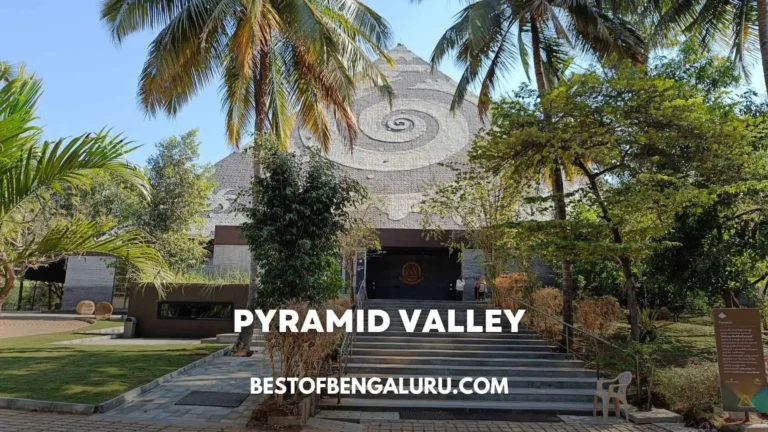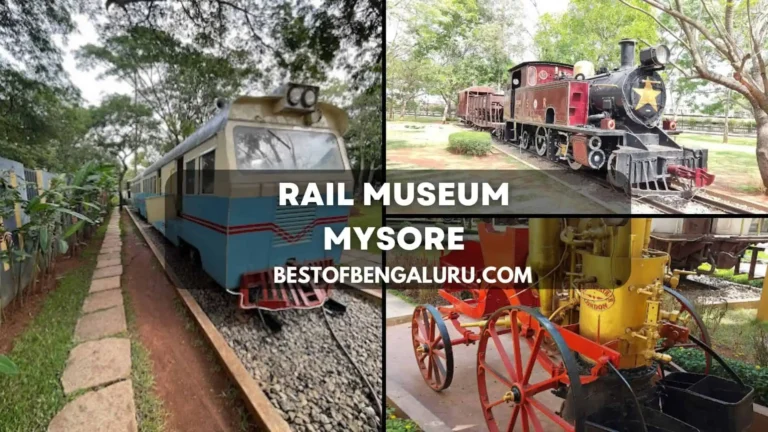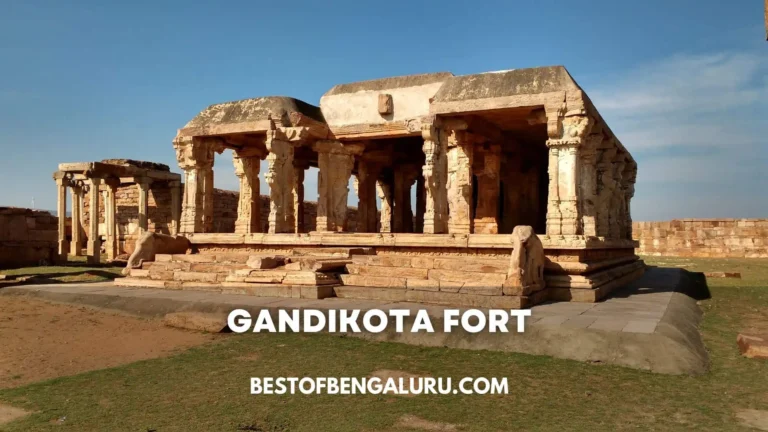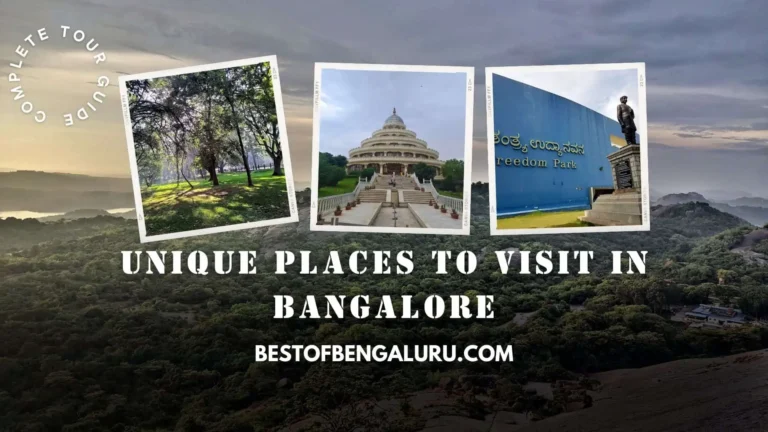Mysore Palace Timings, Photos, Entry Fees, Lighting, History, King Details
Mysore Palace, also known as Amba Vilas Palace, is a historical and royal residence (house). It is located in Mysore, Karnataka, India. It used to be the official residence of the Wodeyar dynasty and the seat of the Kingdom of Mysore. The palace is in Mysore’s center, facing the Chamundi Hills eastward.

Mysore is commonly described as the ‘City of the Palaces’, with seven palaces including this one. However, the Mysore Palace refers specifically to the one within the new fort. Mysore Palace is one of the most famous tourist attractions in India, after the Taj Mahal, with more than six million annual visitors
In this blog post, let’s look at Mysore Palace Timings, Photos, Entry Fees, Lighting, History, King Details.
Consider reading: Best Places to Visit Near Bangalore
Mysore Palace Timings for Visit, Lighting Show, Entry Fees, and Ticket Price
| Mysore Palace Timings | Daily from 10:00 am to 5:30 pm |
| Mysore Palace Ticket Prices | Indian Adults: Rs. 100 Indian Children (10-18 years): Rs. 5 Indian Students (with school letter): Rs. 10 Foreign Tourists: Rs. 200 Free for children below 10 years |
| Mysore Palace Sound and Light Show Timings | 7:00 pm to 7:40 pm (Mon-Sat), 8:15 pm to 9:15 pm (Sat only) Closed on Sundays and public holidays |
| Mysore Palace Sound and Light Show Ticket Price | Rs. 40 (Indian Adults) Rs. 25 (Indian Children 7-12 years) Rs. 200 (Foreign Tourists) |
| Mysore Palace Illumination | Timings: 7:00 pm to 7:45 pm (Sundays and public holidays) Features around 100,000 bulbs No charge for viewing |
Book the Mysore Palace online ticket on the official website.
History of Mysore Palace
Tracing its origins to the 14th century, the Mysore Palace embodies a legacy steeped in royal grandeur. Initially established within the confines of the Old Fort, this palace, crafted by the esteemed Wodeyar rulers, initially showcased wooden architecture.
However, its wooden structure made it vulnerable to fires, leading to several reconstructions over the years. A significant event marking its history was the devastating fire in 1896 during the nuptials of Jayalakshammani, daughter of Chamaraja Wodeyar, which turned the then Wooden Palace to ashes.
In the wake of this calamity, Maharaja Krishnaraja Wodeyar IV, along with Maharani Kempananjammanni Devi, sought the expertise of British architect Henry Irwin to erect a new edifice.
The construction of this resplendent new palace, often referred to as the New Fort, commenced in 1897 and reached completion in 1912. Further enhancements were made under the guidance of Maharaja Jayachamarajendra Wadiyar around 1930.
This palace bore witness to numerous pivotal moments in history, including the coronation of Krishnaraja Wodeyar IV in 1902, the majestic Dasara festivities, Lord Curzon’s visit in 1906, Mahatma Gandhi’s visit in 1927, and the historical transfer of authority to the Government of India in 1950. Recognized as a national monument in 1974, the Mysore Palace is presently managed by the Government of Karnataka.
Consider reading: Mysore Zoo Timings, Entry Fee, Ticket Price, Photos, Animal Details
Architecture of Mysore Palace
Mysore Palace stands as a testament to the Indo-Saracenic architectural style, a remarkable blend of Islamic, Rajput, and Gothic influences. This majestic structure spans approximately 75 meters in length and 48 meters in width, constructed primarily with robust gray granite. Each corner of the palace is marked by imposing square towers, rising to five stories and crowned with elegant pink domes. The central tower, the most striking feature, boasts a gilded dome and a golden flag, symbolizing regal splendor.
The palace’s design includes three primary entrances: the East Gate, which welcomes visitors; the South Gate or Varaha Gate, reserved for the royal family; and the West Gate or Balarama Gate, prominently used during the grand Dasara procession.
Internally, the palace houses a plethora of halls, courtyards, temples, and galleries, each showcasing unique architectural and artistic characteristics. Key highlights include:
- The Ambavilasa (Diwan-e-Khas), the king’s private audience hall, adorned with an ornate ceiling, stained glass windows, elegant chandeliers, and a gold-plated throne.
- The Durbar Hall (Diwan-e-Aam), a public hall for ceremonies and state functions, featuring a lofty ceiling, wooden pillars, intricate paintings, and a silver throne.
- The Kalyana Mantapa (Wedding Hall), an octagonal space for marriages and festivals, with a vibrant stained glass ceiling, peacock motifs, and opulent chandeliers.
- The Gombe Thotti (Doll’s Pavilion), the entrance hall that displays a fascinating collection of dolls, weaponry, and royal memorabilia.
Further enriching its cultural tapestry, the palace grounds encompass twelve Hindu temples dedicated to deities like Shiva, Vishnu, Lakshmi, and Ganesh. The Someshvara Temple, dating back to the 14th century, is the oldest, while the Lakshmiramana Temple is the main shrine for the royal family. Complementing the religious diversity, a mosque and a church are also situated within the palace.
Consider reading: Bangalore Palace History and Details
Grounds of Mysore Palace
Enveloping the Mysore Palace, the meticulously manicured gardens and lush lawns contribute significantly to the estate’s allure and charisma. Spanning approximately 72 acres, the palace grounds are a hub of cultural and recreational activities, featuring:
- The Dasara Exhibition: This annual event, held from September to December, is a vibrant showcase of Karnataka’s handicrafts, arts, and cultural heritage. Attracting thousands of visitors each year, this exhibition is a testament to the rich traditions of the region.
- The Sound and Light Show: An evening extravaganza, excluding Sundays and public holidays, this 45-minute show blends music and lighting effects to vividly recount the history of Mysore and its iconic palace.
- The Palace Illumination: A breathtaking spectacle where the palace comes alive with approximately 100,000 bulbs, illuminating the structure on Sundays and public holidays, creating a mesmerizing visual experience.
Beyond these attractions, the palace grounds are a focal point for various events and festivals. Highlights include the grand Dasara procession, the delightful flower show, diverse cultural programs, and rejuvenating yoga sessions. These grounds are open to the public, offering a perfect setting for picnics, strolls, and photography enthusiasts.
Consider reading: Brindavan Gardens Mysore Timings, Entry Fees, Fountain, and Light Show
Things to do in Mysore Palace
Visiting Mysore Palace is an essential experience for those eager to immerse themselves in the region’s royal legacy and cultural tapestry. The palace offers a myriad of activities to engage and enchant visitors:
- Discover the Palace’s Interior: Embark on a journey through the palace’s corridors to marvel at its architectural splendor, artistic treasures, and historical artifacts. The on-site museum showcases an array of royal family memorabilia, including paintings, photographs, costumes, and jewelry. Additionally, an art gallery within the palace walls exhibits the celebrated works of Raja Ravi Varma, an artist deeply revered by the Wodeyar dynasty.
- Experience the Illumination and Sound and Light Show: Witness the transformation of the palace into a mesmerizing spectacle during the palace illumination, an event that casts a magical aura over the structure. Complementing this visual feast is the sound and light show, an immersive experience that eloquently narrates the rich history of Mysore and its iconic palace.
- Join the Dasara Festivities: Engage in the vibrant Dasara celebrations, Mysore’s most renowned festival. Spanning ten days, this festival epitomizes the triumph of good over evil. The palace serves as the focal point of these celebrations, featuring religious rites, cultural performances, and the majestic Jumboo Savari procession. This procession, a highlight of the festival, showcases the idol of Goddess Chamundeshwari in a golden howdah atop an elephant, concluding with a spectacular torchlight parade at Bannimantap grounds.
- Explore Nearby Attractions: Enhance your Mysore experience by visiting nearby landmarks such as Chamundi Hills, Lalitha Mahal Palace, Mysore Zoo, Brindavan Gardens, and St. Philomena’s Church. Each of these destinations offers unique experiences ranging from natural beauty and wildlife to stunning gardens and architectural marvels.
Consider reading: Mysuru Dasara Festival
How to get to Mysore Palace
Reaching Mysore Palace is convenient, thanks to the array of transportation options available. Whether you’re coming from nearby or afar, you’ll find a mode of transport that suits your needs. Here’s how you can journey to this iconic destination:
- By Train: The Mysore Junction (MYS), also known as Mysuru Junction, is the nearest major railway station. It connects Mysore to key cities like Delhi, Mumbai, Chennai, Bangalore, and Hyderabad. From the station, which is approximately 2 km away, you can easily reach the palace by taxi, auto-rickshaw, or bus.
- By Road: Mysore’s road connectivity is excellent, linking it with various cities in Karnataka and neighboring states. Frequent bus services, including those by the Karnataka State Road Transport Corporation (KSRTC) and private operators, run from cities like Bangalore, Coorg, Ooty, and Wayanad. For those preferring a private journey, hiring a taxi or driving to Mysore is a viable option. Located centrally, the palace is easily identifiable and accessible by following local signboards.
- By Flight: The closest international airport is Kempegowda International Airport (BLR) in Bangalore, about 170 km from Mysore. It serves both domestic and international flights. From Bangalore, you can continue to Mysore via taxi, bus, or train. Alternatively, the Mysore Airport (MYQ) is a closer option, situated around 12 km from the palace, offering limited services from Chennai, Hyderabad, and Kochi.
Consider reading: 20 Best Ooty Tourist Places, Must-Visit Places in Ooty, Garden, Toy Train, Tiger Hill and More
The Best time to Visit Mysore Palace
Mysore Palace, a year-round destination due to Mysore’s temperate climate, offers unique experiences in different seasons. Here’s a guide to the optimal times for planning your visit:
- October to March: This period is widely regarded as the best time to explore Mysore Palace. The climate is cool and dry, providing comfortable conditions for sightseeing. Coinciding with these months is Mysore’s most celebrated event, the Dasara festival. This ten-day extravaganza, symbolizing the triumph of good over evil, sees the palace as the epicenter of vibrant religious rituals, cultural performances, and the grand Jumboo Savari procession. The highlight of the procession is the revered idol of Goddess Chamundeshwari, carried in a golden howdah on an elephant, culminating in a torchlight parade at Bannimantap grounds.
- July to September: The monsoon season brings moderate rainfall to Mysore, transforming the palace gardens into a lush, green haven. This period also coincides with the Dasara exhibition, an annual showcase of Karnataka’s rich handicrafts, arts, and cultural heritage, running from September to December.
Summary: The prime time for visiting Mysore Palace is from October to March, aligning with the city’s grand Dasara festival and favorable weather conditions. Alternatively, the monsoon season from July to September offers a different charm, with verdant palace grounds and the colorful Dasara exhibition. Each season brings its unique allure, making Mysore Palace a captivating destination throughout the year.
Tips for visiting Mysore Palace
Embarking on a visit to Mysore Palace, a symbol of regal heritage and cultural diversity, can be enriched with some thoughtful planning. Here are key tips to ensure your visit is both enjoyable and memorable:
- Advance Planning and Online Ticket Booking: To streamline your visit, plan ahead and consider booking your entrance tickets and sound and light show passes online via the official Mysore Palace website. This strategy helps bypass long queues and optimizes your time.
- Comfort in Attire and Footwear: Given the extensive walking involved, opt for comfortable clothing and footwear. Note that shoes must be removed before entering the palace. For added convenience, you can utilize the battery-operated vehicles provided by the government for a more relaxed tour of the palace grounds.
- Essential Items to Carry: Always have a valid photo ID (passport, Aadhaar card, driving license) ready for verification at the entrance. Carrying a water bottle and snacks is advisable, as food facilities are not available within the palace premises.
- Adherence to Palace Etiquette: Show respect for the palace’s preservation by adhering to its rules. Do not touch or damage artifacts, paintings, or structures. While photography and videography are not permitted inside, feel free to capture the external beauty of the palace and its gardens. A free camera custody counter is available at the entrance for your convenience.
- Enhancing Your Tour with Guided Insights: For an immersive understanding of the palace’s history, architecture, and the royal family’s legacy, consider hiring a government-approved guide or using an audio kit. These are available in multiple languages including English, Hindi, Kannada, German, Italian, Japanese, and French, providing a comprehensive cultural experience.
- Exploring Surrounding Attractions: Complement your palace visit with trips to nearby landmarks like Chamundi Hills, Lalitha Mahal Palace, Mysore Zoo, Brindavan Gardens, and St. Philomena’s Church, each offering unique experiences from natural vistas to architectural marvels.
Closing Thoughts on Mysore Palace
Mysore Palace is one of the most splendid and majestic palaces in India, and a must-visit destination for anyone who wants to experience the rich cultural heritage of Mysore. The palace showcases the glorious history of the Wodeyar dynasty, who ruled Mysore for over five centuries.
The palace is also famous for its stunning architecture, which blends Islamic, Rajput, and Gothic styles, and its dazzling illumination, which lights up the palace with thousands of bulbs every evening.
Mysore Palace is not just a monument, but a living testimony of the royal legacy of Mysore. If you are planning to visit Mysore, make sure you do not miss this magnificent attraction, which will leave you spellbound by its beauty and grandeur. Mysore Palace is truly a wonder of India.
FAQs on Mysore Palace
Why is Mysore Palace famous?
Mysore Palace is famous for its stunning Indo-Saracenic architecture, designed by Henry Irwin. A key attraction in Mysore, it’s renowned for its grandeur, intricate interiors, and ceremonial practices. The palace’s illuminated façade during festivals makes it a must-visit cultural landmark in India, captivating tourists worldwide.
What is the entry fee for Mysore Maharaja Palace?
The Mysore Maharaja Palace entry fee is INR 40 for Indian adults, INR 20 for Indian children, and INR 200 for foreign visitors. Students with a valid ID can enter for INR 10. Separate charges apply for the light show: INR 40 for adults and INR 25 for children.
Which Kings palace is Mysore Palace?
The Mysore Palace, also known as Amba Vilas Palace, was the regal seat and official residence of the Wadiyar dynasty, who ruled the Kingdom of Mysore. This historic edifice stands proudly in Mysore, Karnataka, bearing testament to India’s royal heritage.
Which day Mysore Palace is closed?
Mysore Palace is closed to visitors on Sundays and public holidays. For a seamless trip planning experience, remember to check the latest schedule updates before your visit to this historic Indian landmark.





